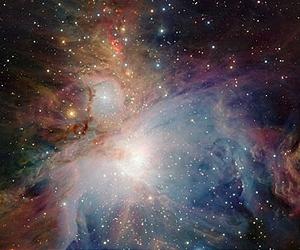
An international team of astronomers led by Fukue and Tamura of the National Astronomical Observatory of Japan conducted research on the properties of light in a massive star-forming region (BN/KL nebula) of the Orion Nebula and have investigated a process that may have played a role in the development of life on Earth.
The origin of what is technically called "biomolecular homochirality" is a longstanding mystery and an important one to solve, since it characterizes most life forms on Earth.
Chirality refers to the handedness of an image or phenomenon, which is not identical to the mirror image of its counterpart, much as the right and left hands are similar in structure but are opposites and thus not the same.
Homochirality means that a group of molecules exhibit the same handedness. Therefore, biomolecular homochirality indicates an organic group of molecules that are characterized by the same handedness. Terrestrial living material displays homochirality and consists almost exclusively of one enantiomer, L-amino acid, one of a pair of amino acids.
What is intriguing is that amino acids in several meteorites show enantiomeric excesses of the same handedness as that seen in biological amino acids. Therefore, the process that produced the handedness of amino acids in the meteorites may provide clues to how homochirality developed in life forms on Earth. The larger question becomes how enantiomeric excesses can be produced and under what conditions.
Addressing this question became the context within which the research team worked as they made observations of the Orion Nebula, one of the brightest and closest regions of high and low mass star formation near Earth. Since enantiomeric excesses can be produced by circularly polarized light, the research team focused on observing the degree of circular polarization in the star-forming region of the Orion Nebula.
They developed the circular polarimeter for SIRPOL on SIRIUS, which is a wide-field near-infrared camera that works at three near-infrared bands (J-, H-, Ks-bands) simultaneously. They used SIRPOL to measure the polarity with SIRIUS on the IRSF (Infrared Survey Facility) 1.4 m telescope in South Africa.
Their results include the presentation of a wide-field and deep near-infrared (Ks band: 2.14 micron) circular polarization image of the Orion Nebula, where massive stars and many low-mass stars are forming. This image reveals a circularly polarized region that is spatially extended around the BN/KL nebula, a massive star-forming region.
The circular polarization here is high and significant, extending over a region about 400 times the size of the Solar System, an area observed that is much larger than that of previous studies.
Other regions contrast with this one and show no significant circular polarization. Unlike the BN/KL nebula, most of the low-mass young stars do not demonstrate a detectable extended structure in either linear or circular polarization.
The researchers infer that their results indicate a process that could have played a role in the development of biological homochirality on Earth.
They reasoned that if our Solar System formed in a massive star-forming region like Orion's, then circularly polarized radiation could have induced enantiomeric excesses in the parent bodies of meteorites and subsequently delivered to Earth.



Reader Comments
to our Newsletter